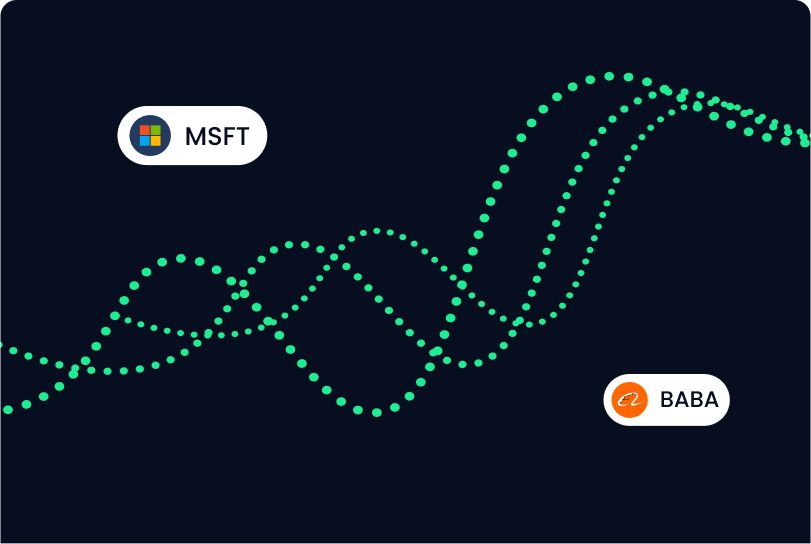
10 minute read
Which Stock Is Best for Swing Trading?
Finding the right stocks for swing trading can make all the difference between consistent profits and frustrating losses. After 15+ years in the markets, I've learned that successful swing trading isn't just about technical indicators or market momentum—it's about selecting the right targets. Let's explore which stocks offer the best opportunities for swing traders in today's volatile market environment.

🏆 Start Trading With Exness – Register Now! 🚀 or Visit the Broker’s Website ⭐
What Is Swing Trading and How Does It Work?
Swing trading sits in that sweet spot between day trading and long-term investing. Instead of closing positions by the end of each day or holding stocks for months, swing traders typically keep positions open for several days to a few weeks to capture "swings" in market momentum.
This approach works by identifying stocks in the midst of a short to medium-term trend. We look for stocks that are bouncing between support and resistance levels—those predictable zones where prices tend to reverse direction. The goal is simple: buy at support and sell at resistance, or short at resistance and cover at support.
What makes swing trading particularly attractive is its balance of time commitment and profit potential. You don't need to be glued to charts all day like day traders, but you can still generate more frequent returns than traditional buy-and-hold investors. I typically spend about an hour each evening scanning for setups and managing existing trades.
Trading psychology plays a huge role here. You need to be disciplined enough to stick to your exit strategy, whether you're taking profits or cutting losses. I've blown up more than one account by letting a "swing trade" turn into an "investment" after it moved against me.
Key Criteria for Selecting Stocks for Swing Trading
Not all stocks make good swing trading candidates. Through years of trial and error, I've narrowed down these essential criteria:
Liquidity – Look for stocks trading at least 500,000 shares daily. This ensures you can enter and exit positions without significantly moving the price.
Volatility – Ideal swing trading stocks have Average True Range (ATR) values that provide enough price movement to make the trade worthwhile. Too little volatility means minimal profit; too much increases risk.
Clear technical patterns – Focus on stocks forming recognizable chart patterns like flags, triangles, or head-and-shoulders formations.
Sector trend alignment – Select stocks in sectors showing strong directional momentum.
Price range – Stocks between $20-$100 often work best; they're not too expensive to build positions in but still attract institutional interest.
Institutional interest – Check for significant but not excessive institutional ownership (20-70% is the sweet spot).
Earnings schedule – Avoid holding positions through earnings announcements unless that's specifically part of your strategy.
I learned the importance of these criteria the hard way. A few years back, I tried swing trading a low-volume biotech stock. When negative news hit, there were simply no buyers, and I couldn't exit without taking a massive loss.
Top Sectors and Industries for Swing Trading
Some sectors consistently provide better swing trading opportunities than others. Based on recent market behavior and historical patterns, these sectors tend to offer the most profitable setups:
Technology stocks remain swing trading favorites due to their volatility and clear trend patterns. Companies in cloud computing, cybersecurity, and semiconductor subsectors frequently display the ideal combination of liquidity and price swings.
Financial stocks, particularly regional banks and fintech companies, tend to react predictably to interest rate expectations and economic indicators. I've found these particularly useful when trading around Federal Reserve announcements.
Healthcare presents interesting opportunities, especially in medical device and healthcare tech segments. These stocks often have lower correlation to the broader market, creating unique swing trading setups.
Consumer discretionary stocks provide excellent swings during seasonal cycles. Retail companies in particular tend to follow predictable patterns around earnings seasons and major shopping events.
Energy stocks have become increasingly volatile with fluctuating oil and natural gas prices, creating ideal conditions for swing traders who can navigate the price action.
I've personally found the most consistent success with technology and financial stocks. Last quarter, a semiconductor equipment manufacturer gave me three separate profitable swing trades as it bounced between clear support and resistance levels.
Best Stocks for Swing Trading in 2025
Based on current market conditions and trading activity, these stocks are showing promising swing trading characteristics in 2025:
Nvidia (NVDA) continues to display clear technical patterns with reliable support/resistance levels despite its higher price point. The AI narrative creates predictable swing opportunities.
Bank of America (BAC) offers excellent liquidity and frequently trades in identifiable channels, making it ideal for swing strategies around economic announcements.
AMD (Advanced Micro Devices) shows consistent volatility patterns that swing traders can capitalize on, especially as it competes with Intel and Nvidia in various chip markets.
Walmart (WMT) provides more conservative swing trading opportunities with its steady trading patterns and predictable reactions to retail sales data.
Chevron (CVX) has developed reliable technical patterns that correspond to both oil price movements and broader market sentiment.
These are just examples based on recent performance. Always conduct your own analysis before entering trades. I recently caught a nice 8% swing on AMD by entering when it bounced off its 50-day moving average and exiting when it approached previous resistance.

Tools and Platforms to Identify Swing Trading Opportunities
Finding profitable swing trades consistently requires the right toolset. These are the platforms and tools I rely on daily:
TradingView stands out for its powerful charting capabilities and custom indicator options. Their scanner functionality lets me quickly filter stocks based on my specific swing trading criteria.
FinViz offers excellent screening tools to identify stocks meeting technical and fundamental requirements. Their visual maps also help identify sector rotation patterns that create swing opportunities.
StockCharts.com provides reliable charting with excellent sector rotation tools that help identify which industries are gaining momentum.
ThinkorSwim from TD Ameritrade delivers institutional-quality analysis tools with customizable scanners specifically for swing trading setups.
Market Internals indicators like the NYSE Advance/Decline Line and TICK index help confirm the market's overall direction before taking swing positions.
I personally use a combination of TradingView for charting and FinViz for initial stock screening. This combo helps me identify about 3-5 high-probability setups each week, which is more than enough for active swing trading.
Risk Management Strategies in Swing Trading
No discussion of swing trading would be complete without addressing risk management. In fact, this is where most traders fail. Here are the risk management rules I live by:
Position sizing – Never risk more than 1-2% of your total account on any single trade. For a $10,000 account, that means a maximum loss of $100-$200 per position.
Stop-loss placement – Set stops based on technical levels, not arbitrary dollar amounts. I typically place stops just below key support levels or beyond the stock's average daily range.
Risk/reward ratios – Only take trades offering at least 2:1 potential reward compared to risk. For every $1 I'm willing to lose, I want at least $2 in potential profit.
Correlation awareness – Avoid having too many positions in correlated stocks or sectors. Diversify your swing trades across different industries.
Gradual position building – Consider scaling into positions rather than entering full-size immediately. This reduces the impact of false breakouts.
Trailing stops – Once a trade moves in your favor, consider using trailing stops to protect profits while allowing for further upside.
Market environment filtering – Adjust position size based on overall market volatility. Take smaller positions during uncertain periods.
I follow these rules religiously now, but it took blowing up two trading accounts in my early days to truly internalize them. When I first started swing trading, I would routinely risk 10% or more per trade—a recipe for disaster.

🏆 Start Trading With Exness – Register Now! 🚀 or Visit the Broker’s Website ⭐
Common Mistakes to Avoid When Swing Trading Stocks
Through years of trading and coaching other traders, I've identified these common pitfalls and how to overcome them:
Problem: Overtrading Too many traders feel compelled to always be in a position, leading to forcing trades on weak setups. Solution: Be patient and wait for A+ setups that meet all your criteria. It's better to miss opportunities than take poor trades.
Problem: Ignoring the broader market Individual stocks rarely swim against the market's tide for long. Solution: Always check major index trends before entering swing trades. In downtrends, focus more on short setups or reduce position sizes for longs.
Problem: Moving stop losses The temptation to give trades "more room" by widening stops is a path to large losses. Solution: Set stops based on technical levels and treat them as non-negotiable. If you're uncomfortable with the stop placement, the setup isn't right for you.
Problem: Holding through earnings Earnings announcements can gap stocks well beyond your stop loss, creating outsized losses. Solution: Either exit positions before earnings or specifically plan trades around these events with appropriate position sizing.
Problem: Counter-trend trading Fighting strong trends rarely works, even if a stock looks "oversold" or "overbought." Solution: Trade with the prevailing trend, using pullbacks in uptrends for entries and bounces in downtrends for short entries.
I still remember a painful lesson from trying to short Tesla during its massive 2020 rally because it looked "overextended." The stock continued higher for weeks, proving that fighting strong trends is usually a losing proposition.
Can You Swing Trade Stocks on Exness?
Exness primarily focuses on forex, metals, energies, cryptocurrencies, and stock indices rather than individual stocks. While you can't directly swing trade individual stocks like Apple or Amazon on Exness, you can apply swing trading techniques to the available instruments.
For traders interested in equity exposure, Exness offers stock indices like the S&P 500, Nasdaq, and Dow Jones, which can be effective for swing trading broader market movements. These instruments capture the collective movement of major stocks, making them suitable alternatives for swing traders looking for equity exposure.
The platform provides competitive spreads and leverage options that work well with swing trading timeframes. Their execution quality is also reliable, which is critical when timing entries and exits based on technical levels.
I've personally used Exness for swing trading forex and indices, applying the same technical analysis principles I use for stock swing trading. The MetaTrader platform they offer provides all the necessary charting tools for identifying swing trading opportunities.
🏆 Start Trading With Exness – Register Now! 🚀 or Visit the Broker’s Website ⭐
Frequently Asked Questions (FAQ)
What is the ideal holding period for a swing trade?
Typically 2–14 days. Most profitable trades happen within 3–5 days. Let technical levels, not time, guide your exits.
Can swing trading be done with small capital?
Yes. You can start with as little as $1,000–$5,000. Focus on proper risk management and aim for realistic gains per trade.
Does Exness allow stock trading suitable for swing strategies?
Exness doesn’t offer individual stocks but provides indices like US500, US30, and USTEC — ideal for swing trading strategies.
What are the best instruments on Exness for swing trading?
Major forex pairs (EUR/USD, GBP/USD), indices (US500, USTEC), and gold (XAUUSD) offer good liquidity, volatility, and clear patterns.










